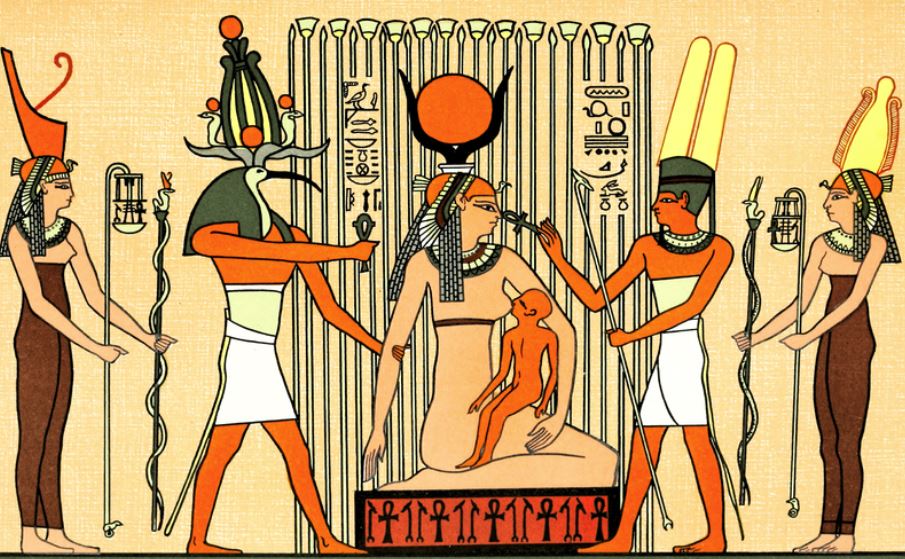Isis was one of the most revered deities of ancient Egypt. She was associated with fertility, motherhood, and the life-giving powers of the Nile.
Her worship was deeply rooted in Egyptian culture and mythology. Over time, her influence spread far beyond Egypt.
The cult of Isis gained popularity in the Roman Empire, becoming one of the most widespread religions of its time. This article explores Isis’ journey from the temples of Egypt to the heart of Rome. It highlights the architectural and artistic influences, rituals, and the cult’s lasting legacy.
- 1. Isis and Her Egyptian Origins
- 2. Early Temple Life
- 3. The Spread of the Cult of Isis Beyond Egypt
- 3. The Cult of Isis' Arrival in Rome
- 4. The Mysteries of Isis
- 5. Isis in Roman Architecture and Art
- 6. Public Celebrations of Isis
- 7. Political Dimensions
- 8. Social Impact
- 9. The Legacy of Isis and its Transformation
- Final Thoughts on Isis
- Further Reading
1. Isis and Her Egyptian Origins
Isis began as a local Egyptian deity. She represented the ideals of motherhood and fertility. Her power was tied to the life-giving waters of the Nile. Every year, as the river flooded, Egyptian farmers praised her name.
The myths surrounding Isis spoke of incredible devotion.
When her husband Osiris was murdered, she searched tirelessly for his scattered remains. Through magical knowledge, she restored him to life. This act made her a symbol of resurrection and eternal love.
Her role as mother to Horus added another layer to her appeal. She protected her son from countless dangers. This resonated deeply with Egyptian mothers. They saw in Isis a divine reflection of their own maternal instincts.
Her magical powers set her apart from other deities. Stories told of her learning the secret name of Ra, the sun god. This knowledge gave her unprecedented power and many Egyptians sought her aid in matters of magic and healing.
2. Early Temple Life
Egyptian temples to Isis buzzed with activity. Priests performed intricate rituals at dawn and dusk. They burned incense and made offerings of food and wine. The air rang with the sound of sacred rattles called sistrums.

Common people visited these temples regularly. They brought their hopes and fears to the goddess. Some asked for healing. Others sought protection for their children. Many prayed for a good harvest.
Water played a crucial role in Isis worship. Temple pools symbolized the Nile’s fertile waters. Priests used these sacred pools in purification ceremonies. Devotees believed the water held healing properties.
Temple gardens grew special plants. These were used in ceremonies and medicines. Lotus flowers, sacred to Isis, floated in temple pools. Their opening and closing mirrored the cycle of death and rebirth.
Daily temple life followed strict routines. Morning began with the awakening of the goddess. Priests bathed and dressed her statue. They presented her with meals throughout the day. Evening ended with prayers and the sealing of the shrine.
3. The Spread of the Cult of Isis Beyond Egypt
Alexander the Great’s conquests changed everything. As Greek culture mixed with Egyptian traditions, Isis gained new followers. The Ptolemaic rulers of Egypt then promoted her worship throughout their territories.
Sailors and merchants carried stories of Isis across the Mediterranean. They built small shrines in foreign ports. As her reputation as a protector of seafarers grew stronger, people far from Egypt’s shores knew her name.
Greek philosophers found depth in Isis worship.
They saw her as a symbol of universal wisdom. Writers praised her as “the one who is all.” Her image then appeared on coins and jewelry throughout the Greek world.
3. The Cult of Isis’ Arrival in Rome
Rome’s first encounter with Isis was met with suspicion.
Isis worship likely arrived in Rome in the 40s or 30s BCE, initially as a private cult. The first public temple dedicated to Isis and Serapis in Rome may have been proposed around 43 BCE, though it’s uncertain if it was actually built at that time.
Conservative senators saw foreign cults as a threat and tried to ban her worship several times. These attempts failed.
The goddess found support among the common people and women especially connected with her message.

Slaves and foreigners also discovered hope in her teachings and her temples became havens for those seeking comfort and community.
Early Roman temples were modest affairs. They began as private shrines in homes, but gradually, public temples appeared in neighborhoods. The goddess gained followers despite official opposition.
Political tensions surrounded her worship. Some saw her as a threat to Roman values. Others welcomed her as a source of divine wisdom. These conflicts played out in public debates and senate meetings.
By the late 1st century BCE, larger temples began to be constructed for Isis, and names associated with her became more common. The cult of Isis spread throughout the Roman Empire, reaching its peak popularity around the 2nd century CE. At this time, Isis was worshipped by people from all levels of society, from emperors to slaves.
4. The Mysteries of Isis
Secret initiation rites drew many to Isis. These “mysteries” promised spiritual transformation. Initiates underwent fasting and purification. They participated in dramatic ceremonies recreating the Osiris myth.

The experience was deeply personal and followers believed they formed a special bond with the goddess. They emerged from the mysteries feeling renewed. Many claimed to have glimpsed divine truths.
Preparation for initiation took months. Candidates studied sacred texts and symbols, learned special prayers and gestures, whilst priests guided them through preliminary rituals.
The final ceremony lasted several days, where initiates faced symbolic death and rebirth.
5. Isis in Roman Architecture and Art
Roman temples to Isis blended Egyptian and Roman styles. Obelisks stood beside classical columns and hieroglyphs decorated walls alongside Latin inscriptions. The Iseum Campense in Rome showcased this fusion perfectly.
Artists created new images of Isis. They kept her Egyptian crown and sistrum. But her face and dress became more Roman. Some statues showed her in flowing Greek-style robes. Others depicted her in Roman military dress.
Temple decoration told stories in stone. Relief carvings showed sacred myths. Wall paintings depicted ritual scenes. Every surface carried religious meaning.
Architectural innovations served ritual needs. Temples included pools for sacred water. Underground chambers hosted mystery rites. Courtyards held crowds during festivals.
6. Public Celebrations of Isis
The Festival of Isis, known as the Navigium Isidis, was an annual celebration held on March 5th. and became a major Roman festival. It marked the beginning of the sailing season. Crowds gathered to watch elaborate processions, where decorated ships were carried through the streets.
This festival demonstrated remarkable longevity, persisting even after official persecution of non-Christian religions. It survived the Christian persecution by Theodosius in 391 CE and was still celebrated until at least 416 CE.
In addition to the Navigium Isidis, other festivals dedicated to Isis developed during the Roman period. For example, the Lychnapsia Philocaliana, a lamp-lighting festival believed to celebrate Isis’s birthday, was recorded in the 4th-century CE Calendar of Philocalus on August 12th.
Priests wore masks representing Egyptian gods. Musicians played flutes and rattled sistrums. Dancers performed sacred movements.
The festival often included a symbolic reenactment of the death and resurrection of Osiris:
- A model of Osiris was created and then ritually “killed” or dismembered.
- Isis, represented by priests or devotees, would then search for and reassemble the body parts of Osiris.
- This reenactment symbolized the cyclical nature of death and rebirth in Egyptian theology.
Different cities celebrated in unique ways. Coastal towns emphasized naval themes, while farming communities focused on fertility aspects and urban centers showcased imperial connections.
Festivals brought communities together. Rich and poor shared in celebrations, Local traditions mixed with official rites. The goddess united diverse groups.
7. Political Dimensions
Different emperors had different attitudes toward Isis.
Augustus kept his distance, as Isis’ connection to Cleopatra made him wary. Later emperors proved more welcoming.
Caligula built temples in her honor and Domitian restored them after fires.
The goddess became part of imperial propaganda as she represented Rome’s connection to ancient Egyptian wisdom.
Some emperors claimed divine connections and portrayed themselves as Isis’s protectors. Religious policy became political strategy.
Local politicians sought temple positions as Priesthoods carried social prestige.
8. Social Impact
Isis worship crossed social boundaries. Wealthy matrons prayed alongside former slaves. Merchants sought her blessing beside sailors. Her temples were rare spaces of social mixing.
Women found special meaning in Isis worship. The goddess understood female experiences. She offered protection during childbirth. She watched over marriages and families.
Temple communities provided support networks. Members helped each other in need. Shared meals strengthened bonds. Religious ties became social connections.
Social advancement came through temple service. Former slaves became priests. Women gained public roles. Merit mattered more than birth.
Temple life created communities, where people gathered for prayers and festivals. . Daily routines brought people together, as they shared meals, built friendships. This common purpose united followers.
Priests served many roles. They performed rituals and counseled believers. They taught initiates and managed properties. They connected heaven and earth.
9. The Legacy of Isis and its Transformation
The worship and celebration of Isis in Rome lasted for approximately 450 years, from its introduction in the late 1st century BCE until at least the early 5th century CE, demonstrating the enduring popularity and resilience of the Isis cult in Roman society.
As Christianity spread, some saw parallels with Isis. The image of Isis nursing Horus influenced early Madonna and Child art and her title “Queen of Heaven” found new meaning.
Some of her festivals merged with Christian celebrations and certain ritual elements survived in new forms. Her legacy lived on in unexpected ways.
Art preserved her memory. Frescoes survived in buried temples and statues remained in public spaces.
Today, scholars study Isis as an example of religious evolution. Her journey shows how beliefs adapt and survive.
Museums display her statues and temples and visitors still admire her serene face. Her story continues to fascinate people and reminds us how ideas and beliefs travel across cultures.
Final Thoughts on Isis
The story of Isis reveals ancient Rome’s cultural complexity. She represents the mixing of traditions. Her cult brought Egyptian wisdom to Roman streets.
More than that, she shows religion’s power to adapt. Her worship changed to meet new needs. Yet her core appeal remained constant. People still sought what she offered: protection, hope, and divine love.
The goddess who began beside the Nile found a home far from Egypt’s shores. Her journey teaches us about cultural exchange. It shows how ancient peoples found common ground in shared beliefs.
Her story remains relevant today. It shows how cultures can blend and grow. It reminds us that human needs transcend time. The search for meaning continues across centuries.
Further Reading
If you enjoyed this article, you may enjoy these:







